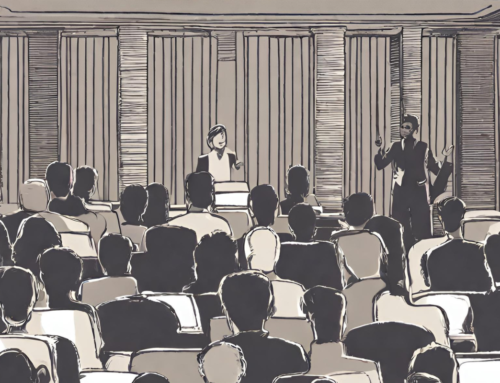The only reason to give a speech is to change the world. The world, in the case of your next speech, is that audience right in front of you. It’s an incredible opportunity – a group of people has voted with its feet and put butts into chairs to listen to you. These people are keen to get something – preferably life-changing – out of the experience. Go for it!
So how do you change that audience? You persuade it to think differently about something. A speech is a persuasive act. Perhaps your goal is only to get them thinking differently, but the best speeches lead to action. The audience hears you, leaps to its feet, and goes forth to conquer malaria. Or save pandas. Or exceed 2014 sales goals.
How do most people attempt to get this difficult feat accomplished? They begin by saying something like, “Let me tell you a little about myself and my company.” Has that kind of opening ever led you to want to change the world?
Or worse, they begin by saying something like this:
Is this thing on? (tapping the mike) Can you hear me? Uh, I, uh, sorry I was a little late. How is everyone out there? I can’t see you, but you’re looking good….I mean, it’s great to be here in Littleton…..
Can we agree to start all speeches more powerfully than that in 2014? Just that one change would lead to happier audiences, more engaged employees, and higher profits worldwide. I guarantee it.
How do you start that persuasive act powerfully? Frame the issue; signal your passion. Start with a story, a stat, or a question. Then take the audience on a persuasive journey.

But if problem-solution doesn’t fit your need, what are the other options?
If the problem is well understood by the audience, but the way forward is unclear, try the statement of reasons. Here, you show how to get to your conclusion by listing and explaining all the important reasons for your point of view. Start with the most important, and work your way down.
Another way is the comparative advantages structure. Here, you brainstorm all the ways in which your point of view, if it prevails, will advantage the audience. List them, once again in order of importance.
Yet another approach, good for when you have a keen understanding of the needs you are trying to address, is criteria – satisfaction. Begin with a discussion of all the issues that need to be covered, then explain how your position will cover them.
A fifth method, one that works well when you’re an authority who commands a lot of respect with the audience in question, is the general to specific method. Here, you begin with the general rule that covers the particular issue under debate. Then you show how the particular fits in, and you’re done.
A final method is the negative method. Here, you eliminate other options, until yours is the only one left standing. This method is particularly good for highly contentious issues, like political debates. Take care to give each of the other options a fair hearing, though; don’t caricature them. That will only alienate the portions of your audience that holds those points of view.
Six ways to persuade an audience to change their minds – and to move them to action. The next time you find yourself standing in front of an audience, no excuses, just do it; change the world.








My opening sentence: You are a survivor from the moment you are diagnosed.
Nice, Eva — you’ve got my attention. How about the rest of the speech?
Nick, If there’s one thing I’ve learned from you over the years (trust me there’s a lot more than one though!) It’s to make the first seconds of my talk unforgettable and buzz worthy. Here’s a recent example: http://youtu.be/Uxm9jCLJFt0
Michael! I’ve got a big grin on my face after watching this perfect opening! You rocked it — love it. Thanks for sharing it…..
Thank YOU Nick! You’ve been a huge inspiration to me for years. My speaking career wouldn’t be where it is if it were not for your work!
With immense gratitude,
Michael
Nick,
Not surprisingly, I LOVED this blog too — it’s what we do isn’t it?
And to show you some new stuff that does it every time (and stuff I think all of us in speaking could use) I need to get you email so that I can send you a small Keynote file.
Looking forward to that and to connecting even more through a magical 2014.
Oh ….. and congratulations on that ‘presidential’ change too!
Paul
Hi, Paul — great to hear from you, and I’m not surprised you’re going to change the world again in 2014! You can email me at nick@publicwords.com. Looking forward to it.